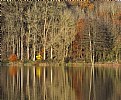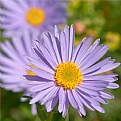
CorrieLynn Jacobsen
(K=9882) - Comment Date 11/13/2005
|
|
|
|
|

lee buckley
(K=15) - Comment Date 11/14/2005
|
What exactly was wrong with the photos? What camera were you using? Is it possible that you can get a lens with a wider aperture?
1. Try a faster film such as Fuji press 1600 (print) film, or if you use slides, try Provia 400 pushed to 1600 (manually set your ISO to 1600 and ask the lab to push the film to 1600)
2. Try a lens with a larger maximum aperture. This will vary depending on your camera, but my used Canon 50mm f/1.8 II lens cost £45
|
|
|
|

Helen Bach
(K=2331) - Comment Date 11/15/2005
|
Fuji NPZ and Kodak Portra 800 can be pushed a little, and that is what I use for theatre if I'm shooting colour negative film. I don't think that it is worth pushing colour neg by one stop, so I push it two stops and set the meter to 1250 or 1600 for NPZ and 2000 for Portra - the current version of Portra seems to push better than NPZ. These settings are below what you might expect for an 800 film pushed two, but they work for me. If you are shooting daylight neg film in tungsten light it is best to overexpose anyway to permit correction later.
If you want to shoot slides, the classic stuff is EPJ (Ektachrome 320T) pushed one, two or three stops (it is worth pushing slide film in one-stop increments). It is balanced for tungsten light.
Best,
Helen
|
|
|
|

Jeff Green
(K=154) - Comment Date 11/17/2005
|
Hi, I have to do some similar work and was wondering what was the least shutter speed I could shoot at to capture the image whith that kind of sensitive film?
I use a nikon N80 with a 28-100 3.5-5.6 G lens
I would be up for any speed of film and I have a flash, but I dont believe the director would let me use it ;)
|
|
|
|

Vojtech Tryhuk
(K=900) - Comment Date 11/17/2005
|
My camera is Canon 300D and for taking pictures on a stage, I use following lens:
20/2.8
50/1.8
200/2.8 (however this one is not mine)
I try to stick to 1/160s with F2.8, that gives in most cases ISO800 or ISO1600. I try to keep that fast time because of fast moves that people on a stage make, it is better than having less noisy iso800 shot with blurred something. Also, I don't use smaller apertures, because of the DOF and also because the lens don't always focus where I want them to. I tried to shoot with MF, but when I saw the result, I could see that all images were out of focus. I never use flash.
|
|
|
|

Ksenia Kopylova
(K=0) - Comment Date 11/24/2005
|
hello, everybody once again... thank you so much for all your kind advices... i will try nikon camera with flash and something like Fuji press 1600 film this time... hope, it will work out :)
|
|
|
|

Ksenia Kopylova
(K=0) - Comment Date 11/24/2005
|
btw, guys, do you use blue filter? nobody, mentioned it :)
|
|
|
|

B M
(K=441) - Comment Date 11/24/2005
|
Very important thing is to measure the light with the spot meter or to go near before the play start end to measure the light from near if you don?t have a spot meter. Of course you have good lenses they are fast but try to shoot based on shutter, so you can freeze the movements. In digital is not a big deal if exposure is a bit under exposed. Use Photoshop to correct the exposure.
Burim Myftiu - Photographer
|
|
|
|

Helen Bach
(K=2331) - Comment Date 11/24/2005
|
" btw, guys, do you use blue filter? nobody, mentioned it"
Well, at least I mentioned the colour temperature issue.
Whether or not you use a filter depends a lot on exactly how accurate you want the final colour balance to be from the shadows to the highlights, and whether you are using daylight-balanced or tungsten-balanced film.
The problem with a full blue correction filter is the loss of about two stops, but if you are shooting daylight neg film it isn't normally necessary to use full blue correction for theatre work. You can either use a light blue filter to give some correction, or no filter at all. If you don't use a filter it helps to overexpose a little, to help the blue layer in the shadows. That's really what determines how you use daylight neg film in tungsten light - how you want the blue layer to look in the shadows.
If you are using reversal (transparency, or slide) film (which you probably aren't, from what you've written so far) then I would advise using a full blue filter with daylight film or, much more preferable, no filter with tungsten film. Ektachrome EPJ (320T) is the fastest tungsten balanced reversal film I know of, and it pushes well - up to three stops if required. The contrast goes up, and there is very little room for exposure error if it is pushed three stops. I use quite a lot of it.
The fastest tungsten balanced 35 mm neg film for C-41 processing is Portra 100T - a bit slow for theatre work. There is movie film available at higher speeds, but processing is not as straightforward as C-41 film because of the carbon-based antistatic/antihalation layer used for movie colour neg film.
Most of the time now I use Portra 800 pushed two stops and rated at EI 2000 with no filter. That gives me the most shadow detail at that EI, and the contrast suits me. In adition to the films already mentioned, you might want to try Fuji Natura 1600.
Regards,
Helen
|
|
|
|

Pat Oates
(K=3046) - Comment Date 11/30/2005
|
Ksenia - I shoot with Nikon D70 (digital), but the principles are the same. I had a similar problem with "stage" photos this last spring. After input from other photographers (if you can't use a flash)you may consider a lens with large aperature. I just looked at a Nikon 85mm F1.4 and it is AWESOME. It can be bought new for around $850. Good luck
|
|
|
|
















